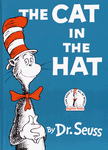| dr.seuss
CAT PEOPLE
 The Cat in the Hat was a Cold War invention. His value as an analyst of the psychology of his time, the late nineteen-fifties, is readily appreciated: transgression and hypocrisy are the principal themes of his little story. But he also stands in an intimate and paradoxical relation to national-security policy. He was both its creature and its nemesis—the unraveller of the very culture that produced him and that made him a star. This is less surprising than it may seem. He was, after all, a cat. The Cat in the Hat was a Cold War invention. His value as an analyst of the psychology of his time, the late nineteen-fifties, is readily appreciated: transgression and hypocrisy are the principal themes of his little story. But he also stands in an intimate and paradoxical relation to national-security policy. He was both its creature and its nemesis—the unraveller of the very culture that produced him and that made him a star. This is less surprising than it may seem. He was, after all, a cat.
Every reader of "The Cat in the Hat" will feel that the story revolves around a piece of withheld information: what private demons or desires compelled this mother to leave two young children at home all day, with the front door unlocked, under the supervision of a fish? Terrible as the cat is, the woman is lucky that her children do not fall prey to some more insidious intruder. The mother's abandonment is the psychic wound for which the antics of the cat make so useless a palliative. The children hate the cat. They take no joy in his stupid pet tricks, and they resent his attempt to distract them from what they really want to be doing, which is staring out the window for a sign of their mother's return. Next to that consummation, a cake on a rake is a pretty feeble entertainment.
[more] |

